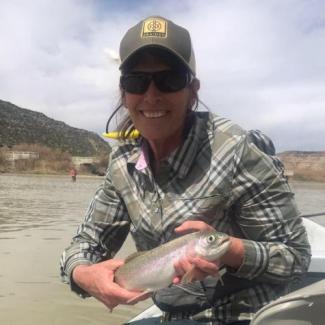 Patt Dorsey is the Director of Conservation Operations for the National Wild Turkey Federation. The NWTF’s mission is delivered primarily through habitat enhancement and conservation projects. The NWTF is working with the USFS and other partners across the US to improve forests. The Rocky Mountain Restoration Initiative, in Colorado, is focused on increasing the pace and scale of forest restoration work. www.restoringtherockies.org
Patt Dorsey is the Director of Conservation Operations for the National Wild Turkey Federation. The NWTF’s mission is delivered primarily through habitat enhancement and conservation projects. The NWTF is working with the USFS and other partners across the US to improve forests. The Rocky Mountain Restoration Initiative, in Colorado, is focused on increasing the pace and scale of forest restoration work. www.restoringtherockies.org
My career path is covered with bear droppings! I was always destined to be a “Smokey-Bear-type” of some sort.
In 1991, I worked for Colorado Parks and Wildlife as a District Wildlife Manager, in Boulder. I protected wildlife by hazing mountain lions to reduce conflicts with pets and people, writing tickets, and counting everything from elk herds to great blue herons. We managed wildlife sustainably, before sustainable was common in the everyday lexicon.
As a hunter, I also understood the counterintuitive notion that hunting deer is good for deer herds. Active management is heavily regulated and driven toward sustainability. In this relatively simple deer example, many diseases, including chronic wasting disease are density dependent. The higher the deer population, the higher the infection rate and mortality. Understanding population dynamics and the species helps wildlife managers find the sweet spot between too many and not enough . . . sustainability.
While I was managing wildlife, City leaders were buying open space to protect a tiny, white orchid: Spiranthes, or Ute Ladies’ Tresses. One purchase was promptly surrounded by an 8′ chain link fence to save the orchids, excluding mowing, winter grazing, and other light disturbances. Within a few years, the orchids were gone. Without management the orchids were shaded out of existence, by competing plants.
No action doesn’t equate to no consequence. That is true for deer, orchids and forests. Conservation or preservation? The differences are nuanced, but important. Preservation lets ecosystems function without human interference. Conservation regulates human interference, actively managing or stewarding our natural resources for a desired outcome.
Like deer, forest health improves with forest management. Forest management is heavily regulated and it works best when it’s science-based, considers societal goals and has a full complement of management tools. Tools for forest management include: do nothing, fire suppression, prescribed and managed fires, mechanical and hand thinning, herbicides and logging.
Just like the tools you have in your home repair kit, one tool doesn’t work for everything. A crescent wrench is necessary and valuable, but some jobs require needle-nosed pliers or a hammer. In reality, most jobs require multiple tools: a wrench, pliers, vice grips and a hammer.
In a forest, prescribed fire is necessary and valuable, but sometimes fuels are too dense or conditions aren’t suitable. Other tools are necessary to achieve the desired goal. And, in reality this too requires multiple tools, thinning, burning, logging, herbicides.
According to the Colorado State Forest Service, there are about 24.4 million acres of forested land in Colorado. Much of that is dense, dry and at risk from uncharacteristic wildfire. In 2019, we were managing about 40,000 acres/year with fuels and forest health treatments. Wildfires, beetles and disease were indiscriminately “managing” 400,000 acres/year. Other Western states from Oregon to Arizona are similar; experiencing increasing tree mortality due to climate, overstocking, beetles and disease.
We don’t need to treat every acre of forest, beetles are native species and not every natural fire is bad. Yet if we want healthier forests and to keep fires from becoming mega fires, the scale of the work in front of us is gargantuan.
With a full toolbox comes flexibility, adaptability and capability. Flexibility to react to changing conditions. Adaptability to use new and better science. And capability to address threats, protect communities and provide timber and water for US citizens.
Going down the rabbit hole and placing blame is time wasted. The combination of climate change, fire suppression, past management, beetles, disease and other factors are intersecting at this point in our history. Today, we have more people living on the forest boundary, recreation is a lifestyle and wildlife habitat desperately needs conserved.
We didn’t create this problem overnight and we won’t solve it overnight. The solutions will be as nuanced and interrelated as the problem itself. We need the full toolbox. One of the biggest issues for us to solve in facing the future of our forests is, “Can we restore our forests at a scale commensurate with the threat?”
Theodore Roosevelt said, “Believe you can and you’re halfway there.”
I believe we can move our forests toward healthier conditions, conserve wildlife habitat, and sustain recreation. Forest health is not a Forest Service problem. It is our collective problem to solve, from Washington state to Washington DC. A problem for all takes all to solve and it takes all the tools available.



